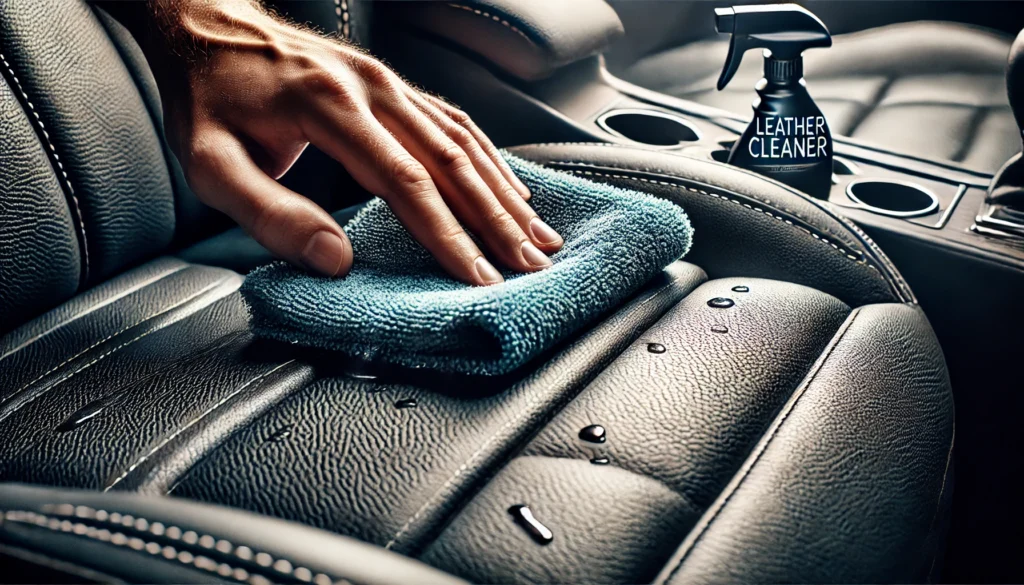
Imagine this: You’re cruising in your car, the sun is out, and life feels just a little bit better. Then, a quick glance at your leather car seats reminds you they’ve seen better days. Maybe there’s an unexpected scuff from that coffee spill last month or a mysterious smudge that refuses to go away. Leather seats add a sleek look to any car, but keeping them clean is more of an adventure than most of us realize.
So, here’s the challenge: how do you clean leather car seats to keep them looking sharp and feeling soft without risking damage?
In this guide, we’ll break down every step in keeping your leather car seats fresh, from the basics of dusting to tips for tackling stubborn stains. If you’re committed to the care and longevity of your leather, this approach will help you avoid the expense of frequent professional cleaning or replacement. With just a little know-how, you can handle regular maintenance and even repair minor issues yourself.
This guide covers:
- Essential tools and supplies for cleaning leather seats
- Step-by-step cleaning instructions for a thorough yet gentle process
- Troubleshooting common leather seat cleaning issues
- Best practices and additional tips to make your leather seats last
- Frequently asked questions to cover all your bases
So, roll up your sleeves, and let’s get into the art of cleaning leather car seats—professionally and safely.
Step-by-Step Instructions for Cleaning Leather Car Seats
Step 1: Gather Your Cleaning Supplies
What to Do: The first step is gathering a few key items that are essential for cleaning leather safely and effectively.
How to Do It:
- Leather Cleaner or Mild Soap: Avoid harsh, all-purpose cleaners as they can damage leather. Opt for a leather-specific cleaner or a mild, moisturizing soap.
- Soft Microfiber Cloths: You’ll need several; some will be used for cleaning and others for drying.
- Soft-Bristled Brush: A small, gentle brush helps with scrubbing in tight areas.
- Leather Conditioner: Helps in maintaining the softness and natural oils in leather after cleaning.
Why It Matters: Using the right supplies prevents damage to the leather’s delicate surface and protects it from becoming dry or brittle over time.
Step 2: Vacuum the Seats Thoroughly
What to Do: Clear the leather of loose dirt, dust, and crumbs with a vacuum before applying any cleaner.
How to Do It:
- Use a soft-bristle attachment on your vacuum and gently vacuum every surface of the seats, paying attention to seams and crevices.
- Avoid pressing too hard on the leather to prevent scratches.
Why It Matters: Dust and grit left on the leather can act like sandpaper when cleaning solutions are applied, scratching the surface of the leather. A quick vacuum clears the slate for a clean start.
Step 3: Apply the Leather Cleaner
What to Do: Apply a leather cleaner to remove dirt and grime from the leather’s surface.
How to Do It:
- Lightly dampen a microfiber cloth with water and add a small amount of leather cleaner.
- Wipe down the seats, working in small sections and applying gentle pressure.
- Avoid soaking the cloth too much, as excessive water can damage leather.
Why It Matters: A dedicated leather cleaner is formulated to remove dirt without stripping essential oils. Over-the-counter or harsh cleaners can dry out leather, leading to cracks and wear.
Pro Tip: Always test the cleaner on a hidden section of the seat to check for any adverse reactions.
Step 4: Gently Scrub with a Soft-Bristled Brush
What to Do: Use a soft-bristled brush to scrub any dirt embedded in the leather’s grain or seams.
How to Do It:
- Dip the brush lightly in the leather cleaner and gently work it into the leather in circular motions.
- Focus on any discolored or stained areas for a more targeted clean.
Why It Matters: A brush lets you reach dirt that sits below the surface, especially in textured leather. Gentle brushing loosens dirt without damaging the leather’s delicate surface.
Step 5: Wipe and Dry the Seats with a Clean Cloth
What to Do: After scrubbing, wipe off any remaining cleaner or residue with a fresh microfiber cloth.
How to Do It:
- Use a dry, soft cloth to absorb any moisture and cleaner left on the seats.
- Go over every section to ensure the leather dries completely, as leftover cleaner can damage leather over time.
Why It Matters: Leather and excess moisture don’t mix well. Drying the leather helps it retain its softness and prevents unwanted stains from moisture buildup.
Pro Tip: For a quick dry, open the car doors to allow airflow or park it in a shady, breezy spot for natural drying.
Step 6: Condition the Leather
What to Do: Conditioning restores natural oils to the leather, maintaining its softness and preventing cracking.
How to Do It:
- Put a small amount of leather conditioner on a cloth and massage it into the leather, focusing on one section at a time.
- Allow the conditioner to sit for a few minutes to soak in.
- Buff the surface with a dry cloth for a smooth, polished finish.
Why It Matters: Over time, leather loses its natural oils, especially with regular sun exposure. Conditioning prevents cracking and keeps the leather feeling supple and looking vibrant.
Pro Tip: Avoid over-conditioning as too much product can leave a greasy residue. Use a conditioner only every three to four months or as recommended.
Read more: How to Clean Leather Bag: The Ultimate Step-by-Step Guide
Troubleshooting & Additional Tips
Common Issues & Fixes
- Persistent Stains: For stubborn stains, reapply the leather cleaner and allow it to sit for a few extra minutes before scrubbing.
- Cracked Leather: Conditioning can help soften small cracks, but for significant cracks, a professional repair is often the best solution.
- Fading Color: Sunlight can fade leather; using UV-protective conditioners or parking in shaded areas helps reduce fading.
Best Practices & Tips
- Avoid Direct Sunlight: When possible, park in shaded areas or use a sunshade to protect leather from UV damage.
- Don’t Over-Clean: Cleaning leather too often can strip it of natural oils. Clean only as needed or once a month for regular maintenance.
- Use Leather-Friendly Products Only: Household cleaners and alcohol-based wipes can harm leather; always stick to products specifically formulated for leather care.
- Keep Conditioner Handy: A high-quality leather conditioner prolongs leather’s life. Invest in a good brand to ensure top-notch protection.
FAQs about How to Clean Leather Car Seats
Q: Can I use vinegar to clean leather car seats?
A: While vinegar is often used in DIY cleaning, it’s acidic and can dry out leather over time. It’s best to use a dedicated leather cleaner.
Q: How often should I clean and condition my leather seats?
A: Cleaning should be done monthly or as needed, while conditioning can be limited to every three to four months.
Q: My leather seats feel sticky after cleaning. What went wrong?
A: Sticky residue may mean too much cleaner or conditioner was applied. Wipe seats with a damp, clean cloth to remove any buildup.
Q: Are leather seats worth the extra maintenance?
A: Yes! With regular care, leather seats can last years while adding a premium feel to your car.
Q: Can I use baby wipes on my leather seats?
A: Although baby wipes are gentle, they aren’t formulated for leather and may contain ingredients that aren’t ideal for long-term leather care.
Conclusion
Congratulations! By following these steps, you’ve equipped yourself with the know-how to maintain your leather car seats like a pro. A regular cleaning routine using the right products and techniques will preserve your leather’s rich look and extend its lifespan, saving you from costly replacements and repairs.

Keeping your leather car seats clean doesn’t have to be a time-consuming chore. A few simple habits, like quick vacuuming and conditioning every few months, will keep them looking fresh and inviting.
If you found this guide helpful, share it with others who might benefit, or check out our other car maintenance guides. Here’s to many more drives with beautifully maintained leather seats!
For a comprehensive cleaning experience, you can integrate some of these practices into your regular car care routine, ensuring you’re always riding in style.
